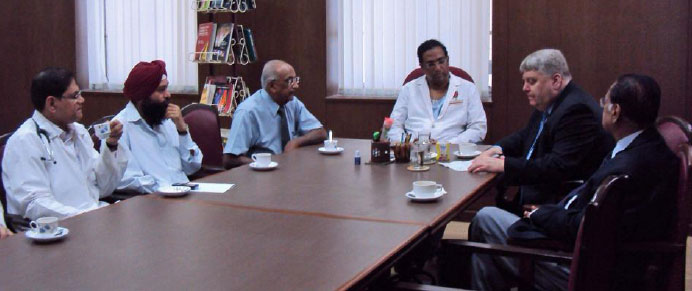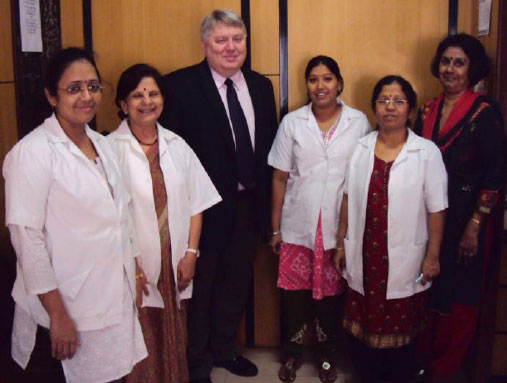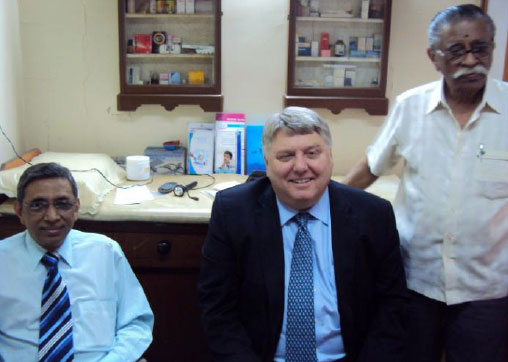From the President: To India - Two Indias
Standing in my room, I hear the adhan, the Muslim call to prayer, float over greater Mumbai (formerly Bombay) and its 20 million inhabitants, 80% of whom are Hindu. My hotel is located in the area known as Bandra, which has the highest concentration of Roman Catholic churches in the world. Gazing west, I see the sun burn bright as it falls into the Arabian Sea. Turning to the southeast, I look past one of Mumbai’s slums, politely known as reclamation land, and in the distance, see a just-completed skyscraper glowing orange-red as it reflects the sun.
Known as Antilia, the edifice is the most expensive private residence in the world. A home like no other, it is valued at USD1 billion, and stands 27 stories tall, like a stack of crystal Lego blocks piled one on another. Looking down, I watch a Mercedes with blacked-out windows glide past a plodding ox cart, on Bullock Street, a name both ironic and British. Every Indian man seems to be working two or three mobile phones as he speeds down the street in the back of a sputtering motorized rickshaw. To say that India is complicated is to state the obvious. And so it goes with Family Medicine in India.
Within a space of six weeks, I attended two meetings of family doctors in India. The first was in Chennai (formerly Madras), a city with one third the population and a fraction of the wealth of Mumbai. Chennai is situated on the southeast coast along the Indian Ocean and is the headquarters location of the Indian Medical Association’s College of General Practitioners (IMA-CGP). The IMA has about 200,000 physicians, with about 20,000 being members of the CGP. Organized by the IMA-CGP, the annual International Congress on Family Medicine attracted about 700 registrants. My IMA-CGP hosts were the President, Dr G Samaram, and the Chief Advisor, Dr S Arul Rhaj, who also serves as President of the Commonwealth Medical Association. They were wonderful hosts. The conference was an excellent meeting and included a number of international speakers.

Prof Roberts meeting with Prof Oak and faculty of Seth G S Medical College
I returned to India to attend the 12th National Convention of the Federation of Family Physician Associations of India (FFPAI) in conjunction with the 41st Annual Conference of the General Practitioner Association (GPA) of Greater Bombay. Dr Ramnik Parekh, the newly installed President of the FFPAI, was superb as my host in Mumbai. Most of the speakers were Mumbai area specialists who shared cutting edge advances in their specialties. The conference was well received by the 850 registrants.
In addition to attending the two conferences, I had the opportunity to meet with medical students, trainees (registrars), and medical school leaders. I was privileged to visit family doctors in their practices both in Chennai and Mumbai. My visits taught me much about the complexity of Family Medicine in India.
In 1968, Delhi hosted one of the four annual world conferences on general practice that led to the official founding of WONCA in 1972. India was one of the original 18 members of WOCNA. Trained in good medical schools, most built during British rule, general practitioners (GPs) in India appeared ready to claim a central role in Indian health care as had British GPs. Then things became more complicated in India.
Rather than building a broad foundation of post-graduate training in family medicine, India medical education constructed a spire of narrowing specialism. Over time, this meant that many Indian physicians became GPs because they were unable to secure a specialty training post, not because they were making a conscious choice to become GPs. India lacked a single unifying advocate for quality Family Medicine, such as a national academy or college connecting all of India’s family doctors. The groups that could rally Indian family doctors, such as a network of local GP colleges linked to a powerful national organization, seemed stuck in feudal perspectives and focused on local issues. Declining interest in general practice and personality clashes among leaders caused India to drift away from WONCA, with no official representation for almost the past decade. Over the past year, India has returned to the WONCA family.
The result of these trends has been two very different Indias when it comes to health care. For the affluent few, India has some of the best technology and sub-specialty experts anywhere. With the world’s largest population of those with diabetes, the Indian solution to obesity and diabetes appears to be laparoscopic bariatric surgery, touted by Bollywood actresses on the television. At the same time, many millions lack access to basic health care, either because of geography with few doctors serving in rural villages, or because of poverty with 75% of Indian health care paid by private funds beyond the means of many. Today’s Indian GPs struggle with low morale and prestige, and inadequate resources. They compete in a chaotic medical market alongside legions of specialists trumpeting all manner of procedures and cures. Few Indian medical students choose careers as family doctors.

Dr Jyoti Parekh (2nd from right) and her staff with Prof Roberts

Dr Vibhakar, Prof Roberts and Harendra Adhvaryu.
Yet, I saw reasons for optimism in India. The tradition of general practice has been preserved by a dedicated cadre of family doctors. Visits to the practices of Dr Jyoti Parekh and Dr N Seth confirmed that Indian GPs did indeed care for families and had relationships going back 40 or more years. One of Dr Seth’s patients travels 2 hours by train to see him. I was encouraged by a meeting with Professor Sanjay Oak, a pediatric surgeon and Dean of the Seth G S Medical College. He has committed to starting a post-graduate course in family medicine. He and his faculty understand the need for robust primary care.
Just as India is poised for greatness, I believe that Indian family medicine is about to soar. Assuring quality family doctors through post-graduate training and continuing education; creating solidarity among Indian family physicians through a well organized national organization; and bridging India’s fascination with technology and specialism with the need for more and better primary and preventive care – these will be the challenges and determinants of success for Indian Family Medicine.
Let me conclude by sharing the story of Doctors Vibhakar (family physician) and Harendra (Ayurvedic physician) Adhvaryu. These two brothers have been practicing together for 40 years, in the same site as their father and grandfather before them. Their business card lists Dr Vibhakar on one side and Dr Harendra on the other side. They consult each other depending on the patient’s problems. With their blend of Occident and Orient, they teach each other and better serve their patients.
It is fortuitous that India has re-connected with WONCA at this time. WONCA can help India advance family medicine, which will be essential for the development of truly equitable and effective health care systems on the South Asia sub-continent. With its passion for innovation and technology, India has much to teach us about transforming primary care to meet the needs of a changing world. With the world’s largest democracy, India also has much to teach us about living with complexity and diversity. It is important for all of us that family medicine thrives in India.
To India: welcome back to WONCA.
Professor Richard Roberts